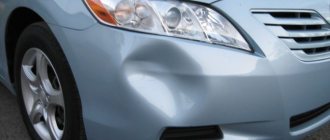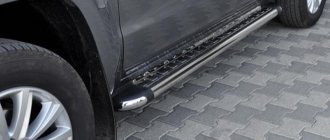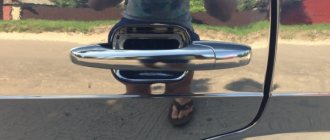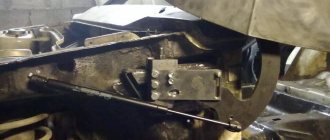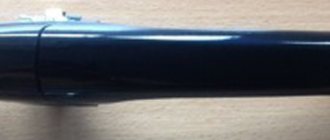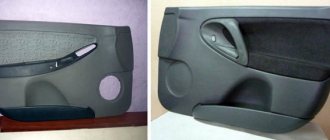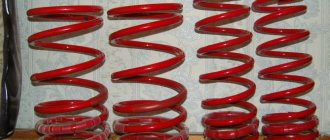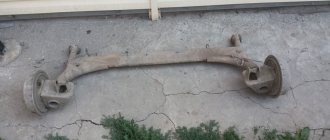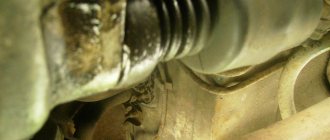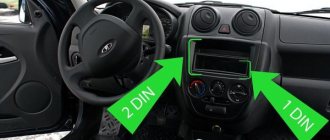A dent on a car body can appear not only as a result of a minor accident. Body parts can be damaged after unsuccessful parking, due to vandalism, or heavy branches falling from trees. In many cases, even a slight impact is enough for metal elements to lose their original geometric shape. If the paintwork remains undamaged, the driver can independently eliminate any defects that have arisen using various available devices and tools. This will save you a significant amount of money on body shop services.
Method for straightening dents using a vacuum cleaner
- To straighten a dent using a vacuum cleaner, you will need a flower pot or small bucket large enough to cover the entire dent. It is better to use the most powerful vacuum cleaner. You will also need tape or masking tape. If there are several holes at the bottom of the pot, then the extra holes need to be sealed. You will also need a sponge, soapy water in a bucket, and an unnecessary towel.
- You need to wash all surfaces where the tape will stick. After this, the surface must be thoroughly wiped dry with a towel so that the tape sticks well. You can put tape on the edges of the pot to avoid scratching the paint.
- Place a pot or bucket over the dent and tape it in place. This will be much easier to do if someone holds the pot in place while you glue it on. The pot doesn't have to be perfectly sealed, but there shouldn't be any obvious gaps. You can also glue additional tape or tape to the back of the pot, the other end of which is glued to the body, so that this tape will support the pot from peeling off and falling.
- Turn on the vacuum cleaner and place the end of the hose over the hole on the potty, as in the illustration. You can wiggle the hose a little to let air in. This way the vacuum cleaner will suck better if it gets a little extra air.
- If you can stick your hand to the back of the dent, you can help straighten the dent by pressing on it. Thus, the impact will be on both sides.
LIFE EXPERIENCE
Today, people everywhere have learned how to straighten dents without repainting, while preserving the factory finish. If you act correctly on the deformed metal, the dent can be completely removed without damaging the durable and elastic paintwork. But an important nuance of the process is that you cannot simply put pressure on the dent. This way you cannot restore the original shape of the part. To understand this, imagine that the door is dented and the owner, inserting a rubber balloon inside, pumps it up. The loads will be distributed so that the broken metal of the dent will not straighten, but everything else will be pulled! You should locally influence some key points, then others, and so on. The matter is extremely painstaking. But they say that it is afraid of the master. And since there is not always direct access to dents from the inside, special levers and hooks are used - of various shapes, sizes, and rigidity. How to use them is again determined by the master.
Heating and subsequent cooling for repairs
Hot metal is ductile and pliable, but to eliminate bruises, some nuances are observed. So, how to remove dents on a car door with your own hands by heating step by step:
Read also: What is Android and its functions
- The trick to heating a concave surface is that after heating it is immediately cooled. When cooled, the iron shrinks, the metal's tension decreases, and the bruise straightens out with a peculiar sound.
- Heating is suitable for shallow defects with a large area. The dented area is heated with a hair dryer or the car is left for a long time under the scorching sun. For quick cooling, use dry ice or a Dust off can to blow off dust from the computer.
- Before heating, wash the dent and the area around it with soapy water - a clean surface will heat up faster.
- The metal must be heated so that the metal is hot in the center of the concavity and cold at the edges. If the entire dent is cooled, the method will not work.
- The heating method is applicable only to defects on metal; it does not work on plastic.
- If the iron does not fall into place the first time, you should repeat the heating and cooling again.
We use a microlift
Here's how else you can do car dent repair without painting yourself. The larger the damage, the larger the piston needed. Glue is applied to the latter. Next, the device is installed in the center of the place for 15 minutes. Then the piston is placed in the groove on the microlift and tightened with a nut. Next, gently press on the handle of the tool. The metal will stretch out - the piston will shoot off, and the remaining glue is removed with alcohol. A bulge will remain, which can be removed with a pencil and hammer. This process may need to be repeated several times until it is completely level.
Removing a dent using a glue gun
To straighten dented body parts using this method, you will need not only the gun itself, but also several pulling elements. The idea is to glue such products at several points on the dent, and then pull them towards you, leveling the deformed metal. As pulling elements, you can use any available devices, similar to those shown in the photo below. For example, they can be made from fragments of wooden dowels, into each of which you need to screw two self-tapping screws, which are necessary to hold them with your hands.
The elements are fixed to the surface of the dent using hot glue. After it has hardened and cooled, you can proceed directly to leveling the body part. It should be taken into account that large deformations should be leveled from the edges. For a small dent, it is enough to glue one dowel in its center.
To remove glued dowels, you need to reheat the glue using a hairdryer. To clean the surface, you can use isopropyl alcohol, which does not harm the paintwork.
DIY straightening methods
Many car enthusiasts cannot afford to carry out repairs in a specialized service center, since this procedure can be quite expensive. In this regard, the question arises: how to remove a dent with your own hands. There is a list of basic methods for removing dents without painting, and all of them are quite simple, since they are done on their own and do not require the involvement of expensive equipment.
Did you know? The first automobile service shop opened in Boston in 1899.
Via magnet
Straightening, in other words pulling out, dents using the magnetic method is quite simple; it is enough to have a powerful magnet to which a handle is attached. This type of repair is ideal for smoothing out small dents.
The repair proceeds as follows:
- The first step is to clean the surface with a regular rag.
- Next, we attach the magnet to the body.
- Then, using the handle that comes from the magnet, we begin to pull out the dent.
- Be careful to only remove the dent and not retighten it.
Important! Before repairing, it is necessary to place something soft under the magnet so as not to scratch the paintwork.
Lever
This process is much more complicated than the previous one. To straighten a dent, you will need a rather expensive set of tools, namely levers.
This repair is carried out when the damage is voluminous and complicated. The whole process involves tapping out dents from the inside of the body. If necessary, you can dismantle some parts that will prevent you from getting to the damaged parts of the body. Hooks and levers have different lengths and shapes, in addition, they are curved at different angles.
- The work surface should be cleaned.
- Then, using a hair dryer, the part is heated to 40–50 °C.
- The edges of the bends need to be tapped and pressed onto the surface, thereby leveling the dent.
We recommend: Do-it-yourself replacement of brake discs on a VAZ 2110
The leveling technology is quite complex. The master selects the lever or hook he needs, uses pressure and tapping to level the surface.
Find out what dent removal kits are available and which one is best to choose.
Via applicator
Dents are retracted using a special kit called “Pops-a-Dent.” The set includes a rocker arm made of plastic, which is curved in a special way. To avoid damaging the surface, it has long legs with a rubberized sponge at their ends.
Hot-melt gun and a set of rods with silicone glue. The kit also includes attachments with different gripping areas, the soles of which are glued to the dent and thus straighten them.
Important! You should definitely see protruding glue through the technological holes; this gives good strength to the fastening itself.
Using the above-mentioned device, it is not difficult to cope with the defect:
- The first step is to degrease the dent itself and wipe it dry. There should not be a speck of dust left on the surface to be treated.
- Melt the glue and apply it to the nozzle as quickly as possible. Press it against the dent, twisting it a little and pressing it half a turn.
- After 2-3 minutes, you need to thread the handle through the eye of the nozzle.
- Then you need to screw the valve onto the thread.
- Slowly straighten the dent until it is level with the metal.
- After this, you should leave everything in this position for 5–7 minutes.
- We unscrew the valve, removing the arc.
- To separate the nozzle, we heat the plastic using a hair dryer, while turning it around.
If your driving skills are very careful, then you don’t have to buy the whole set. It will be enough to purchase only a glue gun. The arc can be made at home yourself, for example, from wood. Instead of rods, you can use an ordinary bolt, gluing its head to the defect.
We recommend that you familiarize yourself with the operating principle of a magnetic inductor - a device for removing dents without painting.
Thermal
The essence of this method is that the metal begins to level out due to a huge temperature difference. To implement this method you must have:
- construction hair dryer;
- compressed air.
The work algorithm looks like this:
- After the dent area is heated, it is cooled using compressed air.
- If the affected area is large, then it is heated in several places.
Rules for straightening a dent
- A body panel stamped from sheet metal acquires so-called “memory”. That is, if a change in the shape of the panel occurs, then this state is unnatural for it; the metal is in a stressed state and strives to take its natural shape. Your job is to relieve this tension.
- You should try to pull out the dent as quickly as possible after it forms. After a long time, the deformed metal, as it were, acquires a new “memory”, like stamped metal, the ductility of the metal decreases. If you do not pull out a dent for a long time, then there is a high probability that a trace of the dent will remain after it is pulled out.
- When a dent forms on the body, the metal not only deepens, the edges around the dent also rise above the general contour of the surface. The more convex the body panel, the more pronounced this is. It turns out something like a small volcano. For this reason, when straightening some dents, you need to tap the raised areas around them (sometimes not noticeable). For smooth dents that do not have wrinkles or damaged paint, light tapping by hand can be done in addition to the other pulling methods discussed in this article.
A dent on a convex or slightly convex surface may have raised areas along its edge.
- When the metal is heated, it is easier to straighten it. In professional body repair and PDR technology, adequate heating of the metal is used to straighten dents. This increases the elasticity of the metal and significantly reduces dent stress. Heating works better on larger dents. A hairdryer is used for heating. A regular hair dryer may not be enough, but it can also make the dent easier to pull out. When using a hair dryer, you should not stop in one place for a long time, as you can damage the paint. You need to use it at medium settings and constantly move it, at a distance of about 10 cm from the surface.
After the initial editing, the master proceeds to finishing the surface with hooks.
Having finished this matter, the tinsmith began to “massage” the dent from the inside. Crochet movements are soft, calculated, without fuss. The process is long - several hours with breaks for short rest for the eyes: they get very tired from the tension and blinding light of the lamp. It is curious that at first the master did not particularly care about the ideal shape of what he got - pits, tubercles. Some of the spectators even began to show concern, but after some time the irregularities began to miraculously disappear, and the Caddy’s wing began to look more and more like a new one. Such is high art! The result is shown in the last picture.
Using a Hot Glue Gun and Pull Tools
p, blockquote 12,1,0,0,0 –>
- For small dents, the pulling element can be glued to the center. Large dents extend from the edges.
- This way you can pull out the jammed stiffening rib, which “holds” the entire dent.
- At the same time, when pulling out dents, you need to tap the high spots, if any.
- To remove the pulling element, heat the glue with a hairdryer. Use isopropyl alcohol to loosen and remove the adhesive.
Pulling out a dent with a reverse hammer
p, blockquote 13,0,0,0,0 –>
You can make a reverse hammer to straighten out dents. To do this, you need a rod 3–5 mm thick and a piece of pipe. You can use hot glue to glue one piece of the hammer to the center of the dent. The principle is the same as when using pulling elements, only the hammer adds additional force through the inertia of the sliding load.
Attachments
At the mastering stage, dent repair will not require very rich tools:
- straightening hammer with shock-absorbing strikers – 300 rubles;
- gas burner Super-Ego R355 – 1.8 thousand rubles;
- portable gas cylinder – 100 rubles;
- stainless steel trowel – 300 rubles;
- hot glue gun – 600 rubles.
In general, your expenses will not exceed 3.5 thousand rubles. If luck inspires you, then buy an inexpensive (3 thousand rubles) set of straightening tools Force F-911M1. You can work with it at a professional level and repair not only your car.
Removing dents on a car using a reverse hammer
The reverse hammer method is effective when there is no chance of reaching deformed parts of the body or their dismantling is impossible. How to level a car door with a hammer:
- Wash and dry the dented part of the body.
- Fix one end of the hammer firmly in the center of the defect using a suction cup.
- Begin to lightly hit the handle of the reverse hammer with a weight that gradually moves along the metal along the concavity.
- After restoring the iron to its original place, unfasten the hammer from the car body.
Before attempting to repair dents on a car yourself, it is recommended to practice on old, unnecessary body parts, if any. The main thing in pulling is not to go too far, otherwise you can squeeze out the metal too much and then you definitely won’t be able to do it without specialists and painting. By the way, the average price for repairing small dents without applying paint is about 700 rubles, front door - 4000, rear door - 5500, trunk - 4500.
Correction with a magnet
Repairing dents on a car without the need for painting using a magnet is one of the easiest ways to restore the surface of parts. For pulling, a magnet is used, which can be purchased at an auto parts store. It has enough strength to straighten small dents. This method removes shallow dents. If the defects are more serious, use another method.
Leveling damage with a magnet on a car is carried out in three stages:
- a cloth is placed between the magnet and the damaged surface to protect the paintwork;
- the magnet is attracted to the edges of the dent and gradually pulls back;
- the tool must be moved around the circle of damage until its central part is reached.
The dent was gone. And the master’s eyes need a long rest
The dent was gone.
And the master’s eyes need a long rest. The dent was gone. And the master’s eyes need a long rest. The described operations cost our accounting department 5,000 rubles. But everyone knows that repairing a wing using traditional methods would cost many times more. The most important thing is that our car, if you check its paintwork with instruments, will remain in the undamaged category! So why is putty still held in high esteem? It's simple. The instantly hardening polyester mass allows you to frankly hack things: you can fashion out of it even something that has long since rotted, then paint the car and get a lot of money from the owner. Of course, the owner of an ancient car can put up with layers of putty while “it” is still driving. But we advise the owner of a new car not to rush to the unfortunate masters under any circumstances. Traditional repair methods create a lot of problems - from corrosion of the dented area to troubles when selling: after all, putty cannot be hidden from modern devices.
So, not all technologies are worth mastering, ignoring specialists. Let us recall the joke: “It’s not at all difficult to walk along a rope stretched across a gorge, just keep your balance!” Would you like to try?
Is vacuum restoration possible at home?
Repairing dents without painting yourself at home is only possible using levers. A microlift is too expensive for an ordinary car enthusiast. It makes the most sense to contact specialized workshops for restoration. Of course, you can always find a tool cheaper. But with this device it is difficult to achieve the same result as with the worldcrolift. You'll have to putty and paint.
1200 rub. for the photo report
We pay for photo reports on car repairs. Earnings from 10,000 rubles/month.
Write:
Removing dents after hail is a completely solvable problem for every car owner whose car has been exposed to this atmospheric phenomenon. To do this, one of four methods of paintless body repair can be used. Each of them has its own advantages and disadvantages, as well as the level of complexity of their implementation. In addition, they use different tools that should be available to craftsmen. We will discuss these repair methods in detail below.
plunger
If dry ice is not found in every Russian home, then everyone probably has a plunger. However, to use this method it is better to purchase a new one - fortunately, these simple tools are inexpensive. And, of course, a plunger is only suitable for small dents, since its diameter is usually small.
The principle of operation is as simple as possible: you need to do exactly the same thing that is usually done with a plunger. That is, push and pull, completely covering the surface of the dent with a rubber valve and pouring a little water on top. Repeat until the problem goes away.
Editing the car body
Straightening is necessary to rid the surface of small but obvious bends and stretches of the body metal. The main task of straightening is to restore the shape of the surface of the part. The curvature inherent in certain body elements should be smooth, looking as if the part was stamped at the factory.
Procedure for carrying out straightening with your own hands:
- visual inspection;
- determination of the type and level of defects that have appeared;
- editing, giving parts their original shape.
To diagnose car body problems, an inspection is first carried out. If possible, use the help of specialist bodybuilders. You can also learn how straightening is carried out from the video at the end of the article.
Plunger and boiling water
The technology for straightening dents using these simple tools is accessible and easy to use. In this case, after the work carried out, only a small polishing of the paintwork may be necessary.
You will need the following materials and tools:
- plumbing plunger;
- ladle or kettle;
- clean rag.
Work should be carried out in this order:
- First you need to remove all removable elements from the car body.
- Then rinse the dent and the adjacent metal with clean water, using special detergents if necessary, and wipe the surface of the body dry with a clean rag.
- Bring the required volume of water to a boil, pour over the damaged area and the adjacent area of the body. This will prepare the working surface for future elastic deformations.
- Immediately install the plunger on the curvature area, starting from the periphery to the center. Each time the rubber cup is sucked onto the metal, pull the handle of the tool towards you. The end result should be complete leveling of the body surface.
If the dent depth is small, one such action may be sufficient. But body deformations with kinking lines require great effort. Complex technologies may be needed here.
Replacing a part or part of it
If there is more serious damage, removing dents will not help restore the integrity of the part. In this case, the body element, or its most severely damaged part, is replaced with a new one. When replacing, it is necessary to find a part identical to the one being replaced. If a specific area is being replaced, the patch is cut from the same metal. Next, it is welded to the part being restored.
Minor damage to the body, chips, scratches and dents on the car can be repaired independently without repainting. Parts of the body that were not previously damaged are subject to restoration. If paint cracking, breaks or kinks appear, repairs without painting will not be possible.
This is what happens on the road: “if you don’t, it hits you,” in the sense that the accident is either your own fault, or the driver of another car is to blame. This is what I decided to write about and more.
So sadness happened to me: I was standing in the parking lot in the evening near the ESSEN shopping center, didn’t touch anyone, went off to stock up, and when I came back, the driver of a Lada Kalina came up to me and said that he hit my car. He says that while parking, he backed up next to my car and was distracted by the child in the back seat - the car rolled forward onto mine and dented the front passenger door. I am sad

